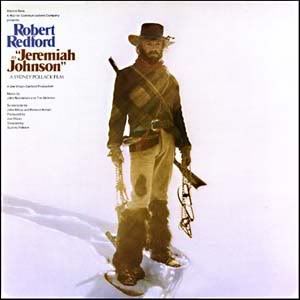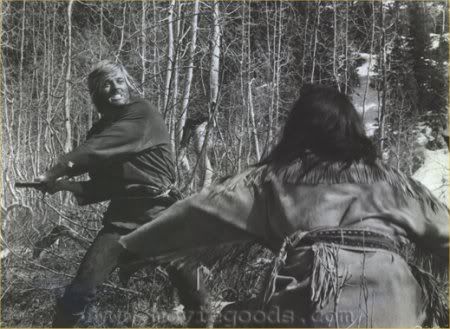'Jeremiah Johnson' (Wikipedia)
Jeremiah Johnson is a 1972 western film directed by Sydney Pollack and starring Robert Redford as the title character and Will Geer as "Bear Claw" Chris Lapp. The film has been said to have been based in part on the life of the legendary mountain man Liver-Eating Johnson, based on Raymond Thorp and Robert Bunker's book 'Crow Killer: The Saga of Liver-Eating Johnson' and Vardis Fisher's 'Mountain Man'.
The script was written by John Milius and Edward Anhalt; the film was shot at various locations in Redford's adopted home state of Utah. It was entered into the 1972 Cannes Film Festival.
I try to be somewhat objective when typing movie reviews, but I think I will put my own stamp on this one. I saw a lot of symbolism that I wanted to delve into. I think 'Jeremiah Johnson' was a great movie, an original western, and it's a distinctly Ameican story. When I viewed it again recently however, I saw even deeper connections. I saw Odinic connections for one thing. The rugged White characters, with their long beards and survivalist mindset, reminded me of the perception of what Germanic tribesman were like. Perhaps something like the Langobards, and the Camunians were a mountain people. Also, the Amerindians represented the northern Mongolians who have historically shared the northern stretches of the Earth. The "son" at the end of Johnson reminded me of a Norse or Viking name, of which it probably has strong connections to. One scene referred to "Jeremiah" as a "Christian name," and I suppose that it could be said that "Johnson" was symbolically his "Odinic name." The movie portrays pure evolutionary struggle.

All of the actors and actresses were good in their roles.. and I thought that the three primary mountain men (Robert Redford, Will Geer, and Stefan Gierasch as Del Gue) were great.. real "characters" in the other sense of the word. Robert Redford and Will Geer are/were so totally different in every way than their characters here... the magic of the movies. The Pagan Amerindians, as well as the White mountain men (my symbolic "Odinic" survivalists) were pure fighting machines.. and I think the movie gave at least a glimpse of that. Apparently, the real man about whom the film was based, "Liver-Eating Johnson," was so fearsome that the Amerindians--rather than hate him--actually honored him. At one point, Johnson asked a settler what the neat collection of artifacts were near his cabin, and the settler told him that it was a monument to him (Johnson). "Some say that you're dead on account of this. Some say that you'll never die on account of this."
There was an actual Del Gue, who was his trapping partner according to the real account. There were a lot of French who came into probably Quebec mostly, and worked their way down into the United States frontiers like the Rocky Mountains, and established rural trade economies. The Rocky Mountains encompass such a vast highlands region in the center of North America, not just Colorado. They stretch from northern New Mexico to northern British Columbia. According to Wikipedia: Mountain men were most common in the North American Rocky Mountains from about 1810 through the 1880s (with a peak population in the early 1840s). The movie at times, sort've symbolically, showed the Rocky Mountains as "the top of the world"... a tremendous allure.
"The Rocky Mountains is the marrow of the world. I ain't ever seen 'em, but my heart tells me that the Andes is foothills and the Alps are for children to climb." --Del Gue
The soundtrack is worth mentioning. It's a blend of American folklore, the spiritual, and nature... and it worked well within the movie. It reflected both nature's harmonious and innocent side.. and it's harsh and violent side. The bear, to me, represents these dual sides of nature. The movie begins with Jeremiah Johnson arriving by river boat at a trading post at the base of the mountains, ready to begin his trek. Soon, a particular wise-looking Amerindian observes Johnson appearing somewhat buffoonish as he tries to catch fish in a river amid the snow. Much later, well after Johnson has been transformed into a legend, he runs into that same Amerindian... but I don't want to give away the powerful scene.
 Numerous scenes during the winter show how harsh and lonely mountain life can be. The vast majority of people today could not survive long if they were placed in that environment, no matter how well equipped they were. The log cabins shown in the movie were great, with a particular wide and low to the ground design. To me, symbolically, this type of transformation of a person is well represented by the "werewolf" concept. Even a soft person could be transformed into a rough, survivalist, fighter if they were pushed to it... and they had the will to survive. In one scene, after he had to fight for his life, he gave out a loud scream... perhaps symbolically like a wolf's howl. A wolf can seem sort've happy-go-lucky... yet can become a ferocious fighter at the drop of a hat. The North American timber wolf is originally from Europe as their DNA has shown; having crossed an ice-bridge long ago. Coyotes are native to North America.
Numerous scenes during the winter show how harsh and lonely mountain life can be. The vast majority of people today could not survive long if they were placed in that environment, no matter how well equipped they were. The log cabins shown in the movie were great, with a particular wide and low to the ground design. To me, symbolically, this type of transformation of a person is well represented by the "werewolf" concept. Even a soft person could be transformed into a rough, survivalist, fighter if they were pushed to it... and they had the will to survive. In one scene, after he had to fight for his life, he gave out a loud scream... perhaps symbolically like a wolf's howl. A wolf can seem sort've happy-go-lucky... yet can become a ferocious fighter at the drop of a hat. The North American timber wolf is originally from Europe as their DNA has shown; having crossed an ice-bridge long ago. Coyotes are native to North America.Part of the transformational concept is that a person living in the wild develops a "sixth-sense," which the movie portrayed. "Bear Claw," who became Johnson's mentor, said "The mountain has its own ways." I think he meant the cycle of nature, the cycle of life, the natural process of things. In this world, nature was in full command. That process is enhanced even more in the harsh mountains. There's a certain inherent morality to nature.
There is a book about the real person named John Johnson, known as Liver-Eating Johnson. It's called 'Crow Killer: The Saga of Liver-Eating Johnson'. The "Crows" were one of the Amerindians tribes, and he went to war with them after they killed his wife and unborn child. That's the account, and the larger "who did what to whom" is something that could be discussed all day. The struggle did symbolize the overall struggle between the two "northern races" over the course of history. Genghis Khan was a northern Mongol who invaded Europe. The earliest fossils in at least North America were proto-European ("Kennewick Man") and were apparently defeated by the incoming Mongols. However, basically these mountain men conducted peaceful trade with the native tribes, and there were missionaries, trading posts, etc.
The other book that the film was based on was 'Mountain Man', a fictional
 account of that period. I still remember that up to the late 70s, when someone liked a movie, there were no DVDs or even VHS tapes to buy. They would buy soundtracks, books, posters, or novelty items about a popular movie. This movie was popular, as it was the seventh highest grossing film in 1972.
account of that period. I still remember that up to the late 70s, when someone liked a movie, there were no DVDs or even VHS tapes to buy. They would buy soundtracks, books, posters, or novelty items about a popular movie. This movie was popular, as it was the seventh highest grossing film in 1972.I don't want to give away too much of the plot, but at one point the Crows kill Johnson's family in what was a revenge attack from their point of view. Johnson--my symbolic Odinic survivalist--gives them what appeared to be a "Viking funeal" by assembling the bodies and burning the cabin. I know, it probably wasn't intended to symbolize that... but I saw Odinic symbolism... or Pagan Amerindian symbolism for that matter. At one point, Johnson warned U.S. Cavalrymen not to enter Crow burial grounds... as they "guarded it with spirits."
The Del Gue character was a real wildman, with a real way with words. Near the end of the movie, he is riding away and gives a particularly great rant about being a mountain man... and it only really makes sense upon actually hearing it. Initially, his gregarious personality and headstrong manner overwhelmed Johnson... who was still a novice. However, upon meeting Johnson much later on, he appears somewhat in awe of the legend.. "Jeremiah Johnson." There were a lot of subtle messages like this that perhaps can't easily be put into words... but they helped make it a great movie.
Below, the theme song from the movie: 'The Way That You Wander'
The way that you wander is the way that you choose,
The day that you tarry is the day that you lose.
Sunshine or thunder, a man will always wonder.
Where the fair wind blows.
At the end of the movie... one extra line is added to the lyrics...
“And some folks say…he’s up there.. still…”
.

No comments:
Post a Comment